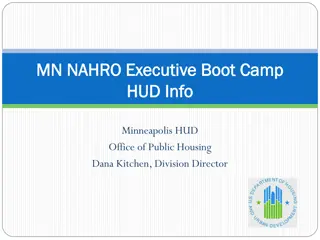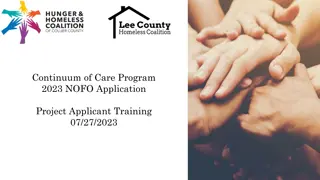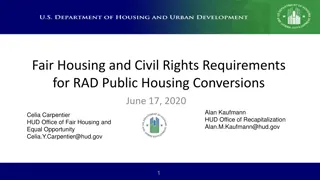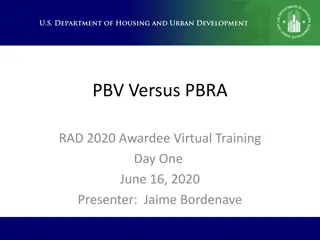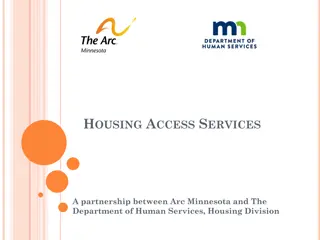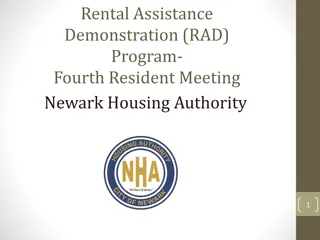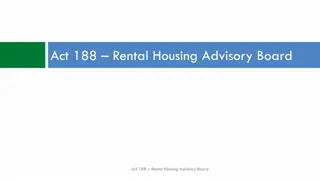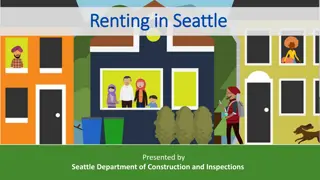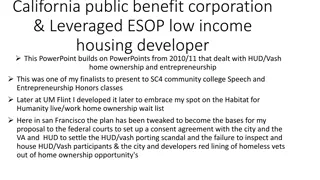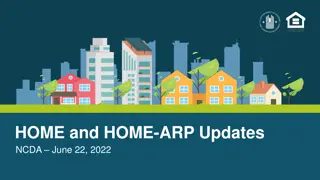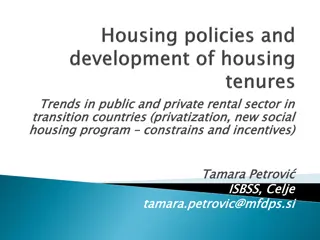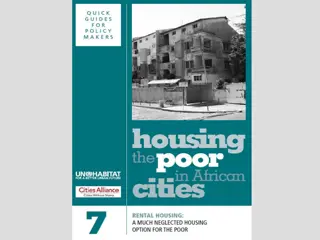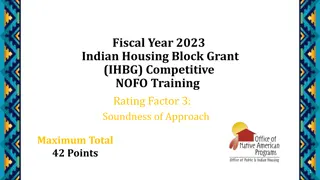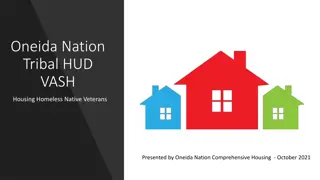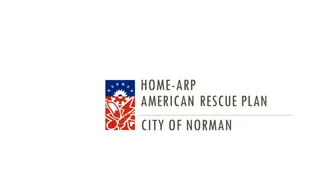Health and Housing Access Among Adults with Disabilities in HUD Rental Housing
This study explores the health status and healthcare access of adults with disabilities who receive rental housing assistance from the U.S. Department of Housing and Urban Development (HUD). It delves into the challenges faced by this population, such as living in poverty and having poor health outcomes, and aims to provide insights for developing effective policies and programs to support their well-being. The research questions whether individuals in HUD-funded rental housing experience poorer health and healthcare access compared to other residents, highlighting the need for more data on this topic.
Download Presentation

Please find below an Image/Link to download the presentation.
The content on the website is provided AS IS for your information and personal use only. It may not be sold, licensed, or shared on other websites without obtaining consent from the author.If you encounter any issues during the download, it is possible that the publisher has removed the file from their server.
You are allowed to download the files provided on this website for personal or commercial use, subject to the condition that they are used lawfully. All files are the property of their respective owners.
The content on the website is provided AS IS for your information and personal use only. It may not be sold, licensed, or shared on other websites without obtaining consent from the author.
E N D
Presentation Transcript
Health and health services access among adults with disabilities who receive rental housing assistance from the U.S. Department of Housing and Urban Development Debra L. Brucker, University of New Hampshire Veronica Helms, US Department of Housing and Urban Development Teresa Souza, US Department of Housing and Urban Development 1
Acknowledgements Funding was provided by the National Institute on Disability, Independent Living and Rehabilitation Research under grant number 90RT5022-02-00. 2
Background 13% of US population lives with some form of disability (Lauer et al., 2017). People with disabilities are more likely to: Live in poverty (Brucker et al., 2015); Have poor health (Altman & Bernstein, 2008; Steinmetz, 2006; Smith et al., 2016); Have higher rates of health care utilization (Albrecht & Devlieger, 1999; Miller et al., 2014; Rasch et al., 2013); and, Participate in public programs such as federally funded rental housing assistance (Brucker & Houtenville, 2014; Souza et al., 2011). 3
Housing assistance Key U.S. Department of Housing and Urban Development (HUD) program categories: Multi-family Private property owners receive subsidies from HUD to provide all or certain percentage of units at affordable rates to low-income persons. Public housing To receive subsidies, tenants are assigned specific public housing units. Housing Choice Voucher Subsidies provided directly to tenants. Tenants can choose where to live, assuming the property owner agrees to participate and to adhere to the program rules. 4
Health and housing The US Department of Housing and Urban Development (HUD) has recently embraced a health in all policies approach. To develop effective policies and programs, HUD needs more information about the health and health care patterns of its residents who have disabilities. Key research question: Are people with disabilities who reside in HUD-funded rental housing more likely to have poor health and health care access than other residents? 5
Data The measurement of disability within HUD administrative data has limitations. National household survey data do not adequately identify persons with disabilities who participate in federally assisted rental housing programs. The National Center for Health Statistics recently collaborated with HUD to create linked data sets in which HUD administrative data was linked with data from the National Health Interview Survey. Available data: https://www.cdc.gov/nchs/data-linkage/hud.htm 6
Methods Key research question: Are people with disabilities who reside in HUD-funded rental housing more likely to have poor health and health care access than other residents? Used pooled health survey data from the 2010-2012 National Health Interview Survey linked with HUD administrative data from a similar time period. Final analytic sample included 1,448 adults 818 without disabilities 630 with disabilities Used logistic regression to assess the likelihood of poor health or health status, controlling for disability, housing assistance program category and individual characteristics. 7
Measures Identified persons with disabilities using six questions about limitations: Ambulatory Cognitive Hearing Independent living Self-care Vision Categorized housing assistance participation as: Multi-family Public housing Housing Choice Voucher 8
Measures Health status Fair or poor Hypertension (ever diagnosed) Asthma (current) Diabetes (ever diagnosed) Obesity (BMI 30 or higher) Cigarette smoker (current) Health care access No health insurance Seen/talked to medical specialist, past 12 months Seen/talked to general doctor, past 12 months Seen/talked to mental health professional, past 12 months Needed but couldn t afford health care, past 12 months Two or more emergency room visits, past 12 months 9
Measures Control variables Age 18-61 62 and older (may be eligible for elderly adult housing) Sex Race/ethnicity Region of country Metropolitan status Poverty level Health insurance coverage (where applicable) 10
Results: Sample 44% had a disability 58% were working age 74% were female 50% did not work in the past 12 months 67% were below the official poverty measure 16% were not covered by health insurance Housing assistance program category: 45% Public housing 29% Housing Choice Vouchers 26% Multifamily 11
Results: Disability Adult residents with disabilities were more likely to have: Fair/poor health status Diabetes Asthma Hypertension Obesity Cigarette smoker Adult residents with disabilities were more likely to have health insurance and to have accessed care in the past 12 months, but were also more likely to report that they could not afford necessary care. 12
Results: Other HUD program category: No significant differences in health or health care access noted. Age: Older adults (age 62 plus) were more likely to report fair/poor health, diabetes, and hypertension and to have seen a general doctor in the past 12 months. Older adults were less likely to be a current cigarette smoker, to have seen a mental health doctor in the past 12 months, or to report an inability to afford needed care. 13
Policy implications 44% of HUD-assisted rental housing adult residents have disabilities. Adults with disabilities are fairly evenly distributed among HUD s three primary housing rental assistance program categories. Although multi-family types of housing include a program that specifically targets persons with disabilities (Section 811 program), people with disabilities reside in ALL HUD-assisted program categories. HUD-assisted adults with disabilities could use more coordination of services to improve health. Service coordinators are available to adults in some multi-family elderly housing. Similar service coordination models could be expanded to more properties that serve elderly and non-elderly adults with disabilities. 14
Policy implications Adult residents with disabilities are more likely to smoke cigarettes HUD recently provided smoke-free guidance in an effort to make all public housing smoke-free and offers a number of resources design to assist public housing authorities, owners, and residents in achieving smoke free environments https://portal.hud.gov/hudportal/HUD?src=/smokefreetoolkits1 15
Contact information Contact information Debra Brucker Research Assistant Professor University of New Hampshire debra.brucker@unh.edu 603-862-1643 16


